TRADITION Book Endorsements (Part 2)

We turned to the members of TRADITION’s editorial board for their recommendations for summer reading – see the project introduction and first round of endorsements here. Below are the remaining entries drawing your attention to the best reading in Torah, Madda, Torah uMadda, or enlightening literature.
Eric Lawee, Rashi’s Commentary on the Torah: Canonization and Resistance in the Reception of a Jewish Classic (Oxford, 2019)
David Berger
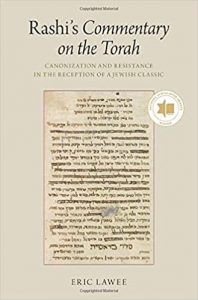
Rashi’s Commentary on the Torah
It is very unusual for a scholar to identify a subject of manifestly great importance that has barely been addressed, but Eric Lawee has succeeded in doing so. We have all consulted supercommentaries on Rashi, but the genre has never undergone serious scholarly investigation. Moreover, the centrality and status of Rashi’s commentary is taken for granted to the point where one does not consider the process by which it achieved that status, let alone the possibility that it could have elicited vigorous criticism and resistance.
Lawee provides an analytical survey of reactions to the Commentary in both Ashkenaz and Sepharad in the Middle Ages, moves to little known works from the Eastern Mediterranean that subject it—and sometimes even the midrashim that it cites—to unsparing criticism from a rationalist perspective, and moves through the late medieval and early modern developments that established its unrivaled standing throughout the Jewish world.
The book ends with a brief Afterword pointing to modern and contemporary developments that in some quarters decanonize the Commentary and in others elevate it almost to equality with Scripture itself.
Throughout, we find specific references to familiar passages in Rashi that we are made to see through fresh eyes. This alone makes the book valuable even to readers who are not concerned with the overarching historical trajectory that renders the study so significant.
Glikl: Memoirs, 1691-1719, annotated with an introduction by Chava Turniansky; English translation by Sara Friedman (Brandeis University Press, 2019)
Rivkah T. Blau

Glikl: Memoirs
What can we gain from reading the memoirs that Glikl, wrote over three hundred years ago? We can meet a buoyant personality, a woman who met challenges in raising her family and dealing in business, who practiced trust in Hashem, and who meant it when she channeled the King Solomon’s approach, “This too shall pass.” We can learn what Jewish life in Europe was like in her time, and see how similar our religious observance is to hers. We can learn that capable women supported their families and protected their communities; one woman even brought a murderer to justice and freed the victims’ wives from being agunot. Glikl undoes the myth of the Jewish woman relegated to the kitchen.
There are two important differences between her day and ours: when plague struck, chasing the sick person and his family from town was a standard way to cope with it. This tied in with a second difference: the ruler of any area could expel the Jews whenever he chose; if a Jew caught the plague, his entire community could be sent away on a moment’s notice. We may daven, as Glikl did, celebrate Shabbat and yomim tovim, as she did, but when her four year-old daughter Tsipor had a sore under her arm—which an old woman insisted was a sign of plague—she had to send the little girl to the farm of a peasant who agreed, for a large sum of money, to keep the child while the sore healed. The Jews of Hanover were adamant that there would be a catastrophe if the Duke learned that a Jewish child was “infected.” On each of the eight days Tsipor spent there, Glikl’s husband Chaim brought kosher food to her; the parents’ joy was intense when they brought her home. We may hear anti-Semitic slurs about the current virus, but we don’t have to face sudden expulsion based on misdiagnosis.
Chava Turniansky, who has spent decades studying Glikl and elucidating Old Yiddish, provides annotations that add to the pleasure of reading a new edition of Glikl: Memoirs, 1691-1719. Sara Friedman, who translated the Yiddish-Hebrew edition into English, conveys the author’s vibrant personality. This is a unique historical document, a gift to the generations. One can learn how to live well and to rejoice in Jewish continuity from Glikl.
Shmuel Khoshkerman, Minhat Shmuel, 2 vols. (Lehitpa’er Press 2016)
Reuven Bulka

מנחת שמואל
My summer recommendation is a two-volume work by Rav Shmuel Khoshkerman. This is a unique amalgam of studies on a wide range of topics, reflecting somewhat the multi-faceted life of the author, who aside from leading Congregation Ner HaMizrach of Atlanta, is a mohel, shohet, and sofer.
The range of the two-volume Hebrew work is quite impressive, including studies on conversion, the international date line, deception, and lotteries, among others that might not seem so surprising. However, some of his topics are more surprising, and very much welcome, such as shadhanut (matchmaking), child custody, and matters related to use of the postal system.
In each of these studies the author anchors the issue in its Biblical and Talmudic roots, and then ventures far afield to apply the conceptual principle to actual situations.
All the entries are well done, and like all good sefarim, encourage the reader to reach beyond the presented text. But the presented text offers quite a treasure of views on the subjects. For example, in discussion of what precisely is the fulfillment of Bikur Holim (visiting the sick) or Nihum Avelim (comforting mourners), the author offers insights that are not reflected in the way these mitzva obligations are usually, but not always correctly, carried out.
There are other topics that are likely to be of special interest to pulpit rabbis, such as the section on setting up the memorial stone. Among other questions, he discusses whether one may add an inscription to an existing gravestone at a later date.
Technology is moving at a fast pace, and the author addresses, as an example, the use of the telephone to fulfill the obligation to comfort mourners. There is a helpful section on the use of computers, faxes, answering machines, not just concerning Shabbat and the Yamim Tovim, but also concerning Havdala and Pidyon HaBen via the telephone.
This leads to my own hope that Rabbi Khoshkerman is contemplating an updated and expanded edition of his excellent work, to include a post-pandemic analysis of Zoom in all its potential applications, including agency and testimony.
Malcolm Gladwell, Talking to Strangers: What We Should Know About The People We Don’t Know (Little, Brown & Co., 2019)
Daniel Z. Feldman
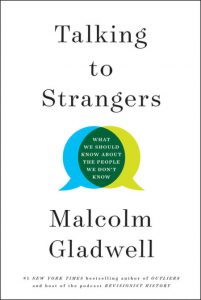
Talking to Strangers
The books of Malcom Gladwell, whicwh have found much popular appreciation, are varied in terms of their innovative contributions. One of his most recent volumes, Talking to Strangers, is particularly significant, in that it contains a number of insights that can prove helpful in seemingly unrelated ways, but possibly most powerfully in ways that are not represented by its title and subtitle.
The theme of the book is a crucial one, at this moment as much as any, as the United States and much of the world are torn and tortured by racial tensions. The book is framed by a description of a tragedy in which a young African American woman died after being pulled over by a police officer, and endeavors to explain the miscommunications and flawed perspectives that causes such interactions to go so horrendously wrong.
However, this perennial quandary, perhaps unsurprisingly, is not solved by the book’s conclusion. What is surprising is the education the reader receives in what might be portrayed as the opposite problem: relationships that are too harmonious, where too much trust is bestowed upon another. Specifically, the book sheds much light on the phenomenon of scandals that are allowed to persist long after they should have been uncovered, due to the reluctance of authority figures to accept the truth of allegations against those whom they know well and appreciate for their service or accomplishments. This is essentially a different subject, albeit one that has also plagued contemporary society and needs to be addressed.
Here, Gladwell details how human nature, especially that of those whose attributes help them achieve positions of authority, includes a tendency to “default to truth,” i.e., to believe in the integrity of their close associates, and only change their positions when the evidence is overwhelming and cannot accommodate alternative explanations. Those who lack this tendency are generally of a disposition incompatible with societal expectations of leadership. While this is difficult to change, his presentation contributes both to a greater understanding of the situation, as well as a greater sympathy for the leadership figures, often unfairly demonized, who are perceived as slow to act. Both the benefits and the consequences of granting of a hezkat kashrut to any person are illuminated.
There are other valuable discussions in the book, including a treatment of the impact of context and environment (and, along the way, the risks of alcohol consumption), but the problem of bias and prejudice remain. To this, of course, there is no easy solution, but continuing exposure to the perspectives and experiences of those who are hurting is in itself productive. For this, one may recommend Jennifer L. Eberhart’s Biased: Uncovering the Hidden Prejudice That Shapes What We See, Think, and Do (2019). Here as well, one may leave unconvinced by the asserted causes or solutions, but the life stories and episodes of pain and discrimination related there allow for a greater identification, and motivation for change.
Controlling the process of thought and predisposition is exceedingly difficult (as may be seen in the prohibition of speaking and listening to lashon ha-ra), and yet, not impossible (as may be seen by the prohibition of accepting lashon ha-ra)—“and neither are you at liberty to neglect the task.” The path remains difficult and unlit, but every step forward is precious progress.
Jewish Legal Theories: Writings on State, Religion and Morality, edited by Leora Batnitzky and Yonatan Brafman (Brandeis University Press, 2018)
Emanuel Feldman, Editor Emeritus
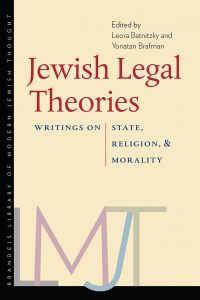
Jewish Legal Theories
The extra time on my hands because of the pandemic—no minyanim, no shiurim—has done strange things, such as sending me to my bookshelves to explore titles that I have long been neglecting. I was immediately rewarded when I alighted upon the recent book Jewish Legal Theories: Writings on State, Religion and Morality. Despite the rather drab academic title, I was very pleasantly surprised. Instead of dry legal discussions, I was treated to a veritable cornucopia of legal and halakhic texts that reflect the wealth of Jewish tradition as it has attempted to cope with the various challenges of modernity.
Comprised of short selections from major Jewish thinkers, secular and religious—from Spinoza and Moses Mendelsohn through R. Ovadia Yosef and R. Shlomo Goren—the reader is exposed to brief but pivotal writings from the beginnings of the modern nation-state, through Eastern European views of Jewish law, to modern haredim, to topics in halakha in the modern State of Israel, and the rise of the feminist movement within contemporary Judaism. Along the way, one encounters familiar figures such as R. Samson Raphael Hirsch, Justice Menachem Elon, and R. Shaul Yisraeli as they grapple with issues brought on by technological and cultural change and revolution.
We are treated to excerpts from the Vilna Gaon, R. Hayyim of Volozhin, R. Joseph B. Soloveitchik, and others, in a treasure house of the finest minds in Jewish halakhic and intellectual history—although I experienced some discomfort in finding the heretical Spinoza in a pantheon together with iconic figures like the Gaon of Vilna, R. Moshe Feinstein, and R. Soloveitchik. Of particular fascination are selections from the classic debates between R. Feinstein and the Satmar Rebbe on the issue of artificial insemination, as well as excerpts on other essential issues from the Haftez Hayyim and the Hazon Ish—all selected and translated skillfully and judiciously.
Throughout, one senses the throbbing pulse and dynamism of classical Jewish law which possesses the vigor and resources to meet head-on the challenges of modern society. Among the few benefits of lockdown—in the midst of the suffering and misery of millions—has been the opportunity to re-visit certain neglected corners of our lives. The discovery of this volume has made quarantine and social distancing a bit more bearable, because it has lessened the distance between me and our precious heritage. I pray to be able to return to my bookshelves in the future without further negative motivations from outside.
Joseph B. Soloveitchik, Shiurim le-Zekher Abba Mari z”l, 2 vols. (Jerusalem, 1983-85)
Menachem Genack

שעורים לזכר אבא מרי ז”ל
Shiurim le-Zekher Abba Mari z”l by Rabbi Joseph B. Soloveitchik compiles many of the yahrzeit shiurim the Rav delivered in memory of his father, R. Moshe. Unlike many of the Rav’s other halakhic writings (and those of his Soloveitchik father, uncle, and grandfather), the language of this sefer is less clipped and dry and more literary, even lyrical. Perhaps this is because the manuscripts on which it is based were prepared by the Rav for the purpose of his delivery, and therefore are closer to the style of his actual oral presentation in front of overflow audiences than to his typical written hiddushim. Although the Rav delivered the shiurim in Yiddish, he wrote the manuscripts for the halakhic portion of the shiurim in Hebrew. (In the early years, the yahrzeit shiurim had an aggadic portion as well, although the sefer includes only the halakhic component of each shiur. Interestingly, while the Rav wrote the halakhic sections in Hebrew, he wrote the aggadic sections in Yiddish. Many transcriptions of these parts of the shiurim were published separately in Hebrew or English.)
The shiurim were mostly, although not exclusively, on subjects related to Orah Hayyim, such as Birkhot ha-Torah and Keriat ha-Torah, Keriat Shema, Kevod ve-Oneg Shabbat, Kiddush and Havdala, and Zimmun. Each shiur begins with a list of questions that the Rav proceeds to deftly resolve with a new conceptual understanding of the topic at hand. For those of us who recall attending these shiurim, at which the Rav held 1,200 participants in rapt attention for hours on end, this sefer brings back, to some extent, the exhilaration of experiencing the Rav’s oratorical brilliance. In addition to the quality of the content itself, what also comes across is the Rav’s masterful pedagogy and the effort he put into his presentation of the material. This sefer is especially meaningful to me because I urged the Rav to publish it, despite his reluctance, and helped him edit the first volume. While not the lightest of summer reading, it is certainly worthwhile.
For those who prefer English or who are looking for something newer, I would recommend Blessings and Thanksgiving: Reflections on the Siddur and Synagogue, edited by Shalom Carmy and Joel Wolowelsky, which includes translations of portions of the yahrzeit shiurim as well as other more philosophical writings of the Rav on prayer. Particularly meaningful in these times is the essay about the concept of tefillah be-tzibbur, “The Synagogue as an Institution and as an Idea,” in which the Rav develops the notion that the tzibbur with whom we are praying is not merely the ten individuals present but encompasses all of Knesset Yisrael.
Adena Spingarn, Uncle Tom: From Martyr to Traitor (Stanford University Press, 2018)
Hillel Goldberg

Uncle Tom
We look at the world through lenses we know to be true—but maybe they’re not. We assume that powerful terms have always had the same meaning as they do now—but maybe they don’t. We equate history with stasis: “Uncle Tom” is derogatory because it’s always been derogatory — but maybe it hasn’t.
A recent book suggests that the classic definition of an “Uncle Tom” is not classic. Wikipedia defines “Uncle Tom” as “a derogatory epithet for an exceedingly subservient person, particularly when that person is aware of their own lower-class status, based on race.” Where else would that definition come from if not the influential, abolitionist tract by Harriet Beecher Stowe, Uncle Tom’s Cabin (1852)? The way it has been interpreted—the opposite of what it says—serves as a warning to any of us engaged in political and religious discourse. It is critical to use terms that are understood the same way on all sides of the political and religious spectrum.
In a nutshell, Adena Spingarn’s thesis is this: “Uncle Tom” the insult is not in the book. It’s a later invention that the book’s author would not recognize. Terms have “parentage,” as the late historian of philosophy, Harry A. Wolfson, put it. Applied to “Uncle Tom,” the parentage metaphor yields an illegitimate offspring of the actual character in Uncle Tom’s Cabin. As summarized by Prof. Douglas A. Jones, Jr., of Rutgers, the Uncle Tom of the novel itself was not a race traitor. Rather: “‘Uncle Tom’ the insult and Uncle Tom the character [in the novel] do not really align: Uncle Tom encourages other slaves in their runaway schemes, but he withholds from his master their plans or whereabouts; he demurs from running away himself because the remaining slaves would have to bear the (financial) brunt of his flight; he refuses to whip fellow slaves; and he declares that he would rather live in the most abject conditions as a free person than in the most luxurious ones as a slave.”
What happened to this decent if fictional pre-Civil War black man? Ironically, the connotation of “Uncle Tom” changed not due to racism, but from within the black community itself. Jones, summarizing Spingarn: “With the wide-ranging demographic changes brought about by the Great Migration [of blacks from the South to the North]; with greater economic and educational opportunities for African Americans, particularly in and around northern and midwestern cities; with black valor during World War I; and with the formation of new ideologies . . . that rejected early programs of racial uplift . . . the ‘Old Negro’ of slavery days and all that he stood for become anathema to the modernist enterprises and sensibilities that dominated black culture and politics.
As the most conspicuous [representative] in American culture, Uncle Tom became the icon of everything the black moderns . . . spurned; he thus emerged ‘in black political rhetoric as an old-fashioned man whose submissive mentality seriously jeopardized racial progress.’”
From the 1910s on, “Uncle Tom” gradually acquired its current meaning: race traitor. The study of history is essential for civil discourse in a polarized environment like our own. Do the words we use mean the same thing to those with whom we disagree?
Adam Hochschild, King Leopold’s Ghost: A Story of Greed, Terror, and Heroism in Colonial Africa (Mariner, 1998)
Elisheva Rabinovich, Editorial Assistant
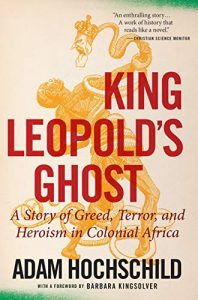
King Leopold’s Ghost
This book is especially timely as King Leopold II of Belgium is back in the news. Just this week protesters took down his statue in Antwerp, and last year the Belgian government first apologized for any wrong-doing during his reign.
King Leopold’s Ghost explores the monarch’s colonization of the Congo through the accounts of individuals who fought against it. Hochschild starts with the story of Liverpool shipping employee Edmund Dene Morel, who notices that the trade ships arriving at the Belgian port from Africa with ivory and rubber are being sent back with only armed officers. His following investigation exposes the slave labor and massacres taking place under Leopold’s rule.
This book was controversial when it first appeared. Some claimed that Hochschild exaggerated both the atrocities and Leopold’s role in them. But for me its biggest flaw is one Hochschild himself addresses in the introduction: “virtually everything we know [about this part of Africa for the next several hundred years] comes to us from its white conquerors.” Between the destruction of official archives, omission of the genocide from museums and the white-washing of the textbooks, we can never fully understand the extent of the damage done.
Why did I choose this book as my recommendation? Like all great summer reading, it is hard to put down. Hochschild is a compelling writer dealing with interesting material. It is also incredibly relevant to our current moment. As our publisher the RCA wrote in a recent statement, we must “educate our society away from racism and towards a better understanding each for the other.” We must also be mindful to educate ourselves about the tough history of racism in America and around the world.
But the main reason to include it on this list is because “the Congo offers a striking example of the politics of forgetting.” Our community emphasizes remembering and internalizing the past. Learning about genocide is central to our education and the estimated 10 million people murdered during this Leopold’s reign deserve to be acknowledged. (Plus, it is always a good idea to read the book before the movie comes out.)
Shachar M. Pinsker, A Rich Brew: How Cafés Created Modern Jewish Culture (NYU Press, 2018)
Jeffrey Saks

A Rich Brew
Standing at the teachers’ room coffee maker during my first month teaching high school in New York a veteran educator asked me which was my mug. When I confessed I did not have my own dedicated vessel to imbibe my cup of joe, she encouraged me to mend my ways and explained, “You’ll never accomplish anything in Jewish education without coffee.” Shachar Pinsker’s fascinating, recent book teaches us that the impact of coffee culture on Jewish life was even greater than that teacher could have known.
Unlike the late Elliot Horowitz’s well-known research into the impact of coffee on Jewish ritual, Pinsker is more concerned with the mise en scène of cafés rather than with the beverage itself. Leading his readers through six central cities at key moments of modern Jewish life, literature, and thought, he demonstrates how coffee houses helped “percolate” Jewish thought, political life, and culture out of the shtetl and into modernity. The cities he focuses on, Odessa, Warsaw, Vienna, Berlin, New York, and Tel Aviv-Jaffa, were all hubs of Jewish culture at different pivotal points in history and each serves as a lens back on to larger events on the world stage through the nineteenth to the mid-twentieth centuries. This produces particularly enlightening vignettes as we experience those places at moments of ferment, urbanization, and migration which transformed Jewish life worldwide
Making one’s way through the book feels like sitting at a table for one, with your own strong cup of coffee. (You want some strudel with that? Sadly, Pinsker largely overlooks what was on the menu in each café.) You eavesdrop on the gentlemen, and very rare woman, at the adjacent table. The delight comes from being in the company of of Agnon, Alterman, Asch, Babel, Benjamin, Berdichevsky, Bialik, and Buber (and that just takes us through some intellectuals and authors whose names begin with A and B). You want politicians, radicals, and revolutionaries?—pull up a chair next to Dizengoff, Emma Goldman, Herzl, Jabotinsky, Trotsky. At booths in the back you can find Yiddish or Hebrew journalists, poets, playwrights, actors, labor organizers, Zionists, or maskilim.
Pinsker shows, especially through his meticulous archival work, and use of contemporaneous newspaper clippings and cultural objects (particularly literature and poetry), how the ideas caffeinated at those tables, in those places and moments, were exported worldwide and helped shape modern Jewish life as we know it.
David I. Kertzer, The Kidnapping of Edgardo Mortara (Knopf, 1997)
Isaac Selter, Editorial Assistant
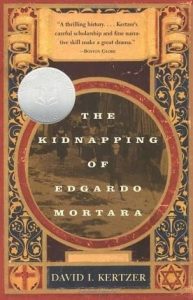
The Kidnapping of Edgardo Mortara
For those well-versed in the annals of Jewish history, the tragic nature of two millennia’s worth of Jewish exile can occasionally lose its poignancy. Ve-hi She-amda becomes just another family tune at the Passover Seder, and Av ha-Rahamim morphs into but another liturgical text whose words zoom out of our lips without giving them much thought. If and when stories of our horrific past do get our attention, we are drawn to focus on national or at least communal calamities, but infrequently do we pay heed to the stories of families, individuals, or six-year-old children.
The Kidnapping of Edgardo Mortara tells of the historical story of a Jewish boy abducted by the Papal police in Bologna during the mid-nineteenth century. Under the pretenses of baptism, Pope Pius IX charged that six-year-old Edgardo Mortara was Catholic, and, therefore, the church was responsible to see to the boy’s Christian education—Edgardo was to be raised in a Christian convent. Kertzer retells this painful story in the form of a novel with tremendous historical scholarship, weaving together a work that doubles as an intriguing history book. Kertzer illustrates the contemporary political context, conveying to his readers the impact the Mortara case had on Italian and world politics alike. Figures like Napoleon III, Ulysses S. Grant, and Moses Montefiore all took interest in securing Edgardo’s release. Protests erupted across Europe and the United States demanding justice for the Mortara family. Kertzer articulates how pivotal this event was in the ensuing unification of Italy, the demise of the Papal States, and the reshaping of Europe as the twentieth century approached.
Readers of this book ride an emotional roller-coaster along with the Mortara family. The crushing defeats of rejected petitions do not stop the Mortaras’ attempts at bringing home their son, both physically as well as theologically. Pure parental love provides the adrenaline for Momolo, Edgardo’s father, to make appeal after appeal to governmental and papal powers, and the glimmers of hope allow the emotional reader to turn page after page in this heart-wrenching adventure.
At the book’s end, after all of the emotion and all of the history, the reader reaches the last page with pangs in his or her heart, now more cognizant of the tribulations of innocent, upstanding Jewish families like the Mortaras living in Christian Europe and others throughout the diaspora. The tragic consequences of exile had drastic effects on even the smallest and most innocent of the Jewish people. Edgardo Mortara was just one of them.
Books of the People: Revisiting Classic Works of Jewish Thought, edited by Stuart W. Halpern (Straus Center for Torah and Western Thought, 2017)
David Shatz
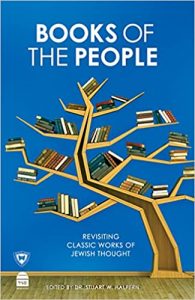
Books of the People
Since the aim of this initiative on TraditionOnline is to recommend books, it seems appropriate and helpful to choose a meta-book—a volume that in turn discusses other books. The cleverly titled Books of the People (a play, of course, on “People of the Book”) covers twelve classics of Jewish thought. Edited by the prolific Stuart W. Halpern, the book mobilizes top-quality authors, nearly all of whom write on a work to which they have devoted significant prior scholarship.
Each author elucidates the chosen book’s contents, but this volume is a far cry from SparkNotes. Rather, each essay examines also the work’s historical context, its author’s biography, and—most challenging but perhaps most important—articulates its contemporary relevance. This broad framework means that even readers already familiar with the works will benefit. The subtitle “Re-visiting” seems fitting.
The Table of Contents [available here along with the editor’s preface], which begins with Saadia’s Emunot VeDeot (by Yitzchak Blau), is worth perusing and will give you a sense of the book’s scope. Notably, the book includes works whose names are widely known but their contents less so: the stories of R. Nahman of Bratslav (Jeremy Dauber), Rav Kook’s Orot ha-Teshuva (Daniel Rynhold), and Rav Hutner’s Pahad Yitzhak (the late Yaakov Elman z”l). As a bonus, R. Jonathan Sacks writes the Foreword, where he describes the role of books in Jewish history and in “the Jewish sense and sensibility.”
As Halpern points out, the volume’s roster of books does not represent a formal canon. But it does reflect “the changing priorities and religious sensibilities of readers and students, whether in the academy or among the general population.” Indeed, several essays deal not with staples of medieval Jewish philosophy, some of which are no doubt consciously omitted, but with mysticism and Hasidut; and one (by Gil S. Perl) examines Netziv’s biblical commentary, Haamek Davar. Needless to say, some readers may favor some other book for a place in the collection, but the editor’s choices are certainly judicious.
R. Sacks, as always, sums up the matter pointedly: “This is where the work begun by Saadia ten centuries ago continues today: the dialogue between Judaism and world, captured in books about the Book that enlarge our intellectual horizons and lift our engagement with God, our people, and the world.”
Norman Lamm, Torah Beloved: Reflections on the Love of Torah and the Celebration of the Holiday of Matan Torah, edited by Daniel Gober (OU Press, 2020)
Joel B. Wolowelsky
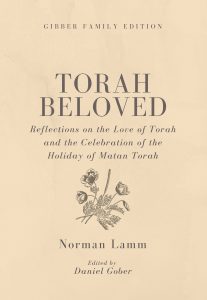
Torah Beloved
Over Shavuot, I reread Torah Beloved, the tenth book in an informal project to bring the late Rabbi Norman Lamm’s sermons to print. Years ago, Pearl Berger, then Dean of Libraries at Yeshiva University, had the wonderful idea of posting all of Rabbi Lamm’s sermons on the Lamm Heritage website at YU, collecting his typewritten manuscripts in a digitally accessible database. Drawing from this treasure trove, I had previously excerpted selections to create a commentary to the Passover Haggada (The Royal Table) and the Book of Esther (Majesty and Mystery), and a collection of sermons related to Yizkor (Memory and Meaning); David Shatz had collected sermons on the holidays (Festivals of Faith); and Stuart Halpern brought out a five-volume set on the weekly parshiot (Derashot leDorot).
This year, Daniel Gober brings us Torah Beloved. It scans across the entirety of Rabbi Lamm’s collection and portrays a general outlook that one should have towards the Torah and its way of life. Additionally, sermons relating to the theme of Shavuot and its relationship to Matan Torah are included. The message is clear. A committed Jew must have an absolute respect and love for Torah. This attitude stands firm against any attack, whether from society at large or from factions within the Jewish culture. Once a person internalizes this love of Torah, he or she is able to accept the Torah anew every year on Shavuot.
To take one example, in “A Premature Obituary and An Immature Religion,” Rabbi Lamm uses the imagery of a midrash to address popular criticisms of the relevance of Torah. The midrash portrays the scene of dark clouds with Moses’ coffin floating in the air after it is “too late” for his return. Rabbi Lamm interprets this to express three often-mentioned attacks on Torah: That it is not aesthetically beautiful, that it is beyond our grasp and not relevant to daily life, and that it is “behind the times.” Just the opposite, declares Rabbi Lamm. The Torah’s beauty is internal, in its ideas and laws, not in its external physical appearance. The Torah is relevant to everyday life—to a life imbued with a recognition of one’s Creator and one’s relationship to his fellow man. And the Torah is not “behind the times” but indeed is “beyond the times”—always relevant to contemporary circumstances. Midrash in his hands is an ever-current source for our contemporary lives.
Week after week over many years Rabbi Lamm wrote out his sermons as he created literary masterpieces for his congregants. Not every congregational rabbi can learn to produce such gems, but they could learn to prepare carefully and well out of respect for their congregants. One cannot but be humbled by Rabbi Lamm’s sweep of topics and sources, and his brilliant creative command of language. That his sermons still read current even now, decades later, is really amazing.
Torah Beloved helps us see that despite all the many and multifarious roles Rabbi Lamm played—public intellectual, thought leader, university president, fundraiser, professor, author, darshan, pulpit rabbi, communal leader, family man—Talmud Torah and his love of Torah was at the center of his life and work. Indeed, the title of the book is the title of his life. May his memory be for a blessing.
Ray Kurzweil, The Singularity Is Near: When Humans Transcend Biology (Viking, 2005)
Shlomo Zuckier
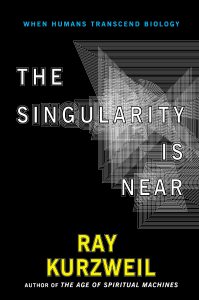
The Singularity is Near
With human interaction over the past three months shifting largely to a virtual interface, it is worth reflecting on the larger phenomenon and longer term future trends of human adoption of technology. At what rate are we incorporating computer function into our lives and experience of the world, and what will be the implications of this?
This important 2005 book by inventor and futurist Ray Kurzweil takes a hyper-optimistic, almost messianic, view, both of the rate at which humans and machines will integrate and approach “the singularity” and at the positive results of such a union.
Kurzweil proposes a few basic principles: technology grows at an exponential rate; at some point human and computer development will essentially merge—a point called the Singularity; in the Singularity, technological development will essentially take over for evolution and human life will be radically and irreversibly transformed; we will soon develop nanobots that exceed natural human capacity in the realm of health (eventually arriving at transhumanism and the option of immortality) and which will be able to construct virtual reality worlds. Kurzweil predicts that this will all be accomplished in the first half of the 21st century!
Reading such a drastically optimistic perspective rather than more nuanced views might open the imagination of the reader to possible future developments, while also priming the religious humanist mind for critiques of or pushbacks to the phenomenon. A few questions that come to mind: Should human enhancement be pursued across the board? Or should limits be applied, and if so, what limits and with what justification? In general, what are the implications of interacting with the world not directly but through the medium of technology, from halakhic, hashkafic, and Humanist perspectives? How might all aspects of our religious life – Talmud Torah, kiyyum ha-mitzvot, Shabbat observance, etc., respond to such advances?
The fact that this book is fifteen years old helpfully allows for some critical distance. Most of Kurzweil’s more ambitious predictions, some of which sound more sci-fi than reality, have not been realized, or at least not yet. At the same time, we have been witness to both human resistance to, and adoption of, technology in recent years and months. This book should be helpful to think with in our increasingly brave new world.
Click here to read the first installment of TRADITION’s summer book endorsements.
[Published June 18, 2020]

 Introduction: A Legacy of Complexity and Truth
Introduction: A Legacy of Complexity and Truth